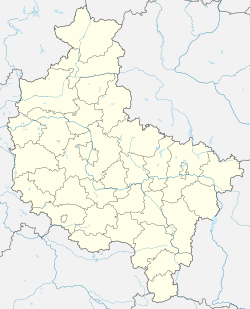Kórnik
Kórnik [ˈkurɲik] (German: Kurnik, 1939-45 Burgstadt) is a town with about 7,600 inhabitants (2018), located in western Poland, about 25 kilometres (16 mi) south-east of the city of Poznań. It is one of the major tourist attractions of the Wielkopolska region and the Greater Poland Voivodeship because of the historical castle and arboretum, which is amongst the oldest and richest collections of trees and shrubs in Poland.
Kórnik | |
|---|---|
 Kórnik Castle and one of its outbuildings | |
 Coat of arms | |
 Kórnik  Kórnik | |
| Coordinates: 52°14′12″N 17°5′55″E | |
| Country | |
| Voivodeship | |
| County | Poznań |
| Gmina | Kórnik |
| Area | |
| • Total | 6.08 km2 (2.35 sq mi) |
| Population (2018) | |
| • Total | 7,619 |
| • Density | 1,300/km2 (3,200/sq mi) |
| Postal code | 62-035 |
| Climate | Cfb |
| Website | http://www.kornik.pl |
History
Until 1961 Kórnik was separate from Bnin, situated just 1 km apart. Both towns were founded in the Middle Ages (Bnin gained town rights in 1395, and Kórnik in 1426), but Bnin lost its town rights in 1934, and in 1961 it became part of Kórnik. The enlarged town also includes the former settlement of Prowent, birthplace of the Nobel Prize-winning poet Wisława Szymborska.
The town's notable sites include:
- Kórnik Castle, built in the 14th century, but designed and rebuilt in the 18th century in neo-Gothic style by architect Karl Friedrich Schinkel for the Działyński family.
- Kórnik Arboretum, established in the early 19th century by Count Tytus Działyński, later enriched with new species and varieties by his heirs, his son Jan Kanty Działyński and grandson Władysław Zamoyski. It is the largest and oldest arboretum in Poland and fourth largest arboretum in Europe, with over 3300 taxa of trees and shrubs.
- Town halls of both Kórnik and Bnin. That of Kornik was built in 1907 as a neo-Baroque city hall; Bnin's is a piece of original 18th-century late Baroque architecture.
- Kórnik Library (Bibliotheca Cornicensis), one of the most famous Polish libraries, founded by Tytus Działyński in 1828. Currently the library, despite being looted by the German Nazis during World War II, is one of the five largest libraries in Poland and contains roughly 400,000 volumes, including 30,000 books more than 150 years old, and 14,000 manuscripts. Since 1953 it has been a part of the National Library of Poland.
During World War II, Kórnik (renamed Burgstadt) was annexed by Nazi Germany from 1939 to 1945 as part of Landkreis Schrimm, Reichsgau Wartheland. On 20 October 1939 a mass execution of 15 local residents was carried out as part of Operation Tannenberg.
International relations
Distinguished residents
- Edmund Zalinski, American military engineer and inventor, born in Kórnik in 1849
- Wisława Szymborska, Nobel prize-winning poet, born in Prowent in 1923
Gallery
 The castle in 1842
The castle in 1842 Print of the castle by Napoleon Orda
Print of the castle by Napoleon Orda Kórnik Castle and its moat
Kórnik Castle and its moat A pond in the arboretum next to the castle
A pond in the arboretum next to the castle Flowers in the arboretum
Flowers in the arboretum All Saints' Church, Kórnik
All Saints' Church, Kórnik- Town hall